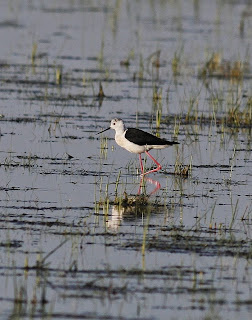Birding trip around the Khangai Mts,
central Mongolia, summer 2013
Twilight at Ogii Nuur, Jul 2013, © T. Hallfarth
part one:
The Lakes
by Thomas Hallfarth
From 13 July to 10 August 2013 I made a birding trip to Mongolia, together with my wife Jana, my son Max and my friend Bernd Möckel (Plauen, Germany). Our principal purpose was to visit the high altitude areas of the West Khangai Mountains around Otgon Tenger and Kukh Nuur. Furthermore, we had arranged some side trips to several lakes for watching waders, waterfowl and other birds. First I’ll report about the lakes at the northern side of our circular trip around the Khangai Mountains.
Our first stop was a nameless floodwater lake several hundred meters south of Lun Sum, a little village between Ulaanbaatar and the Khangai Mountains. A pair of White-naped Cranes foraged around the lake and some Curlew Sandpipers, Long-toed Stints as well as a flock of about 40 White-winged Terns opened our birding trip.
White-naped Crane
Dashinchilen Bayan Nuur, Jul 2013, © B. Möckel
At Dashinchilen Bayan Nuur we spend the first and last night of our journey. This saline lake is a paradise for waders, with approximately 1,500 Pied Avocets roosting. Furthermore, small groups of Dunlins, Temminck’s, Long-toed and Little Stints, Sharp-tailed and Broad-billed Sandpipers were observed plus a single Ruff on our way back. In the reeds alongside a small stream Oriental Reed Warbler, Paddyfield Warbler and Pallas’s Grasshopper Warblers were singing, one or two pairs of Eastern Marsh Harrier hunted in this area whilst one Eastern Water Rail called continuously. Also, passerines typical of meadows were present in good numbers, such as Richard's Pipits, Yellow and Citrine Wagtails and Pallas’s Buntings.
Long-toed Stints
Dashinchilen Bayan Nuur, Jul 2013, © B. Möckel
Marsh Sandpipers
Dashinchilen Bayan Nuur, Jul 2013, © T. Hallfarth
Pallas’s Grashopper Warbler
Dashinchilen Bayan Nuur, Jul 2013, © T. Hallfarth
One of the most important lakes for birding is the Ogii Nuur, situated to the north-east of the Khangai Mountains. We stayed here from 16 to18 July and from 5 to 7 August. Abu wrote in a former blog entry that here was the capital of voles and gerbils in this year—exactly our own impression! These small mammals were swarming all around the lake. Very likely this was the reason for the high abundance of raptors around.
Moulting Upland Buzzard
Ogii Nuur, Jul 2013, © T. Hallfarth
Black-eared Kite
Ogii Nuur, Jul 2013, © T. Hallfarth
We found not less than nine species of bird of prey, including Saker Falcon, Golden Eagle, Steppe Eagle, Pallas’s Fish Eagle and White-tailed Eagle as well as Upland Buzzard. Other spectacular observations included flocks of Pacific Golden Plover, two Sanderlings, two Terek Sandpipers, four Asian Dowitchers and a single Chinese Pond Heron.
Black-winged Stilt
Ogii Nuur, Jul 2013, © T. Hallfarth
Terek Sandpiper
Ogii Nuur, Aug 2013, © T. Hallfarth
Pacific Golden Plovers
Ogii Nuur, Aug 2013, © T. Hallfarth
Chinese Pond Heron
Ogii Nuur, Aug 2013, © T. Hallfarth
Telmen Nuur, the last lake in the first part of my short report, was not so rich for birding. Mongolian Gulls fed their chicks here, several hundred Bar-headed Geese, two Back-throated Divers and a single Eurasian Spoonbill were mentionable.
Mongolian Lark
Telmen Nuur, Jul 2013, © B. Möckel
About our bird-sightings in the high altitude habitats of the West-Khangai Mountains and at the largest Gobi lake, Boon Tsagaan Nuur, I’ll report in the following two parts of this trip report.











